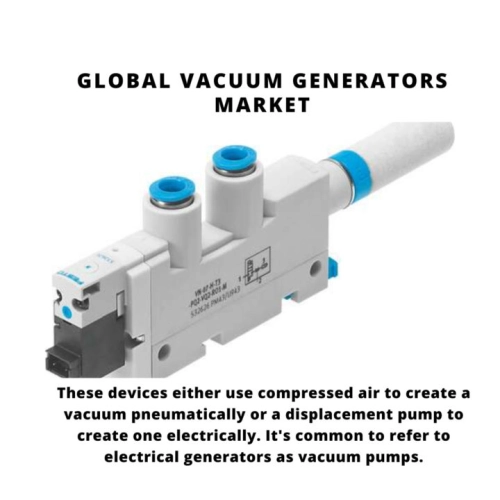
- Get in Touch with Us

Last Updated: Apr 25, 2025 | Study Period: 2022-2030
A vacuum generator, also referred to as a suction pump or ejector, is a kind of pump that can transport fluids from one place to another while removing air and gas molecules from a sealed volume to create a partial vacuum. The level of vacuum produced by vacuum generators is necessary for jobs involving object handling.

These devices either use compressed air to create a vacuum pneumatically or a displacement pump to create one electrically. It's common to refer to electrical generators as vacuum pumps.
The Global Vacuum Generators market accounted for $XX Billion in 2021 and is anticipated to reach $XX Billion by 2030, registering a CAGR of XX% from 2022 to 2030.
Developing Strategic Use of Venturi Vacuum Generators. Fast-acting, localised vacuum-powered devices have long been compatible with air-driven Venturi vacuum generators. They were regarded as practical, adaptable solutions with quick responses throughout the previous ten years.
They were not thought to be energy-efficient, most likely because they used compressed air. For many localised operations, choosing the most energy-efficient products might be challenging due to the extensive product development with this equipment, especially the critical system accessories.
The single-stage Venturi generator circulates air via a conical Venturi aperture in its most basic configuration. The pressure decreases and the velocity rises as the compressed air moves away from the conical orifice restriction and into the wider open lines. The intensity is such that a vacuum is created (lower pressure than the surrounding air pressure), which draws the air that has to be expelled from the operation into the moving airstream and blows it out.
Compressed air is used in single-stage vacuum generators by speeding it down a restrictor tube to produce a Venturi effect, which evacuates the necessary amount of air. Since their fundamental design is geared to meet either the highest flow or maximum evacuation volume requirement, these single-stage Venturi generators are rather constrained in their ability to match numerous applications efficiently.
The ratio of compressed air consumption (scfm) to vacuum flow (the rate at which atmospheric pressure is removed from a system) for this kind of vacuum generator is often no better than 1:1, and occasionally as high as 2 or 3:1. For several applications, multi-stage vacuum generators were created to increase this efficiency.
The multi-stage machines employ a number of ejectors and nozzles to provide controlled expansion of compressed air in stages. By doing this, the ratio of compressed air usage to vacuum flow is typically increased to 1:3 or better. Multi-stage devices can create vacuum at lower pressure and are also noticeably quieter. This performance will lessen the amount of compressed air that is needed under the same circumstances, as well as speed up reactions and boost output.
A multi-stage vacuum generator called coaxial has its multi-stage valves positioned around a tube that is coaxially coated, greatly reducing the flow profile through the generator. The coaxial cartridge can fulfil and supply a wide range of flow and pressure requirements thanks to its design. The coaxial cartridge inside the generator body can frequently be swapped out for another, allowing the same hardware to function under various situations with the best energy efficiency at a reasonable price.
| Sl no | Topic |
| 1 | Market Segmentation |
| 2 | Scope of the report |
| 3 | Abbreviations |
| 4 | Research Methodology |
| 5 | Executive Summary |
| 6 | Introduction |
| 7 | Insights from Industry stakeholders |
| 8 | Cost breakdown of Product by sub-components and average profit margin |
| 9 | Disruptive innovation in the Industry |
| 10 | Technology trends in the Industry |
| 11 | Consumer trends in the industry |
| 12 | Recent Production Milestones |
| 13 | Component Manufacturing in US, EU and China |
| 14 | COVID-19 impact on overall market |
| 15 | COVID-19 impact on Production of components |
| 16 | COVID-19 impact on Point of sale |
| 17 | Market Segmentation, Dynamics and Forecast by Geography, 2022-2030 |
| 18 | Market Segmentation, Dynamics and Forecast by Product Type, 2022-2030 |
| 19 | Market Segmentation, Dynamics and Forecast by Application, 2022-2030 |
| 20 | Market Segmentation, Dynamics and Forecast by End use, 2022-2030 |
| 21 | Product installation rate by OEM, 2022 |
| 22 | Incline/Decline in Average B-2-B selling price in past 5 years |
| 23 | Competition from substitute products |
| 24 | Gross margin and average profitability of suppliers |
| 25 | New product development in past 12 months |
| 26 | M&A in past 12 months |
| 27 | Growth strategy of leading players |
| 28 | Market share of vendors, 2022 |
| 29 | Company Profiles |
| 30 | Unmet needs and opportunity for new suppliers |
| 31 | Conclusion |
| 32 | Appendix |